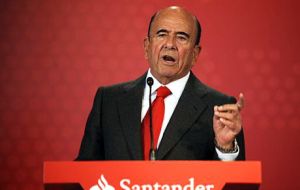MercoPress. South Atlantic News Agency
Emilio Botin, “El presidente” and the 'unofficial king of Spain'
 Botin took advantage of cultural and language ties to expand rapidly into Latin America, and in 2004 snapped up Britain's Abbey National for 14.5bn dollars
Botin took advantage of cultural and language ties to expand rapidly into Latin America, and in 2004 snapped up Britain's Abbey National for 14.5bn dollars  PM Rajoy praised the banker. He used a keen eye for deals to spread Santander's red-liveried brand with its stylized 'S' logo around the world
PM Rajoy praised the banker. He used a keen eye for deals to spread Santander's red-liveried brand with its stylized 'S' logo around the world Emilio Botin, “El Presidente” to co-workers and the third generation of Botins to run Santander, was at the forefront of a drive to create global banks, offering a one-stop shop to multinational companies and a range of services to consumers.
He used a keen eye for deals to spread Santander's red-liveried brand with its stylized 'S' logo around the world, amassing 1.4 trillion Euros of funds and nearly 200,000 employees.
“He was a man who has been able to make Banco Santander the most important bank of our country,” Spanish Prime Minister Mariano Rajoy told journalists in Parliament.
“I had a meeting with him last week and he was well and in good form. It has been a surprise and a blow.”
Botín shook up Spanish banking with a campaign to attract depositors in 1989, forcing rivals to compete on price, and bought troubled Banesto in 1994 to create Spain's biggest bank.
He took advantage of cultural and language ties to expand rapidly into Latin America, and in 2004 snapped up Britain's Abbey National for more than 9 billion pounds (14.5bn dollars).
More canny deal-making followed. In 2007, Santander made 2.4 billion Euros in three weeks through deals to buy and then sell Italian bank Antonveneta. And while partners RBS and Fortis were driven to seek state bailouts after a carve up of ABN Amro on the eve of the financial crisis, Santander emerged comparatively unscathed with the Dutch group's healthier Brazilian arm.
The expansion helped to shield Santander from the Euro zone debt crisis and Spain's long-running recession, with the bank now making only about 14 percent of its profit at home.
But it has not been all success. Santander has trailed the total returns to shareholders delivered in the past 10 years by rivals JPMorgan and HSBC, two firms Botín liked to measures himself against, according to colleagues.
There has been controversy too. Botin's family, which owns barely 2% of Santander, paid 200 million Euros in penalties in 2011 to avoid charges of tax evasion related to a secret Swiss bank account.
Few doubt Ana Botin, 53, has a strong claim to succeed her father. But her high profile in the bank has drawn criticism.
“Botin was the unofficial king of Spain. His death creates uncertainty and a power vacuum at the top,” said a London-based hedge fund manager, who declined to be named.
“The obvious successor is his daughter Ana, which was always the plan, but he hasn’t had a proper chance to groom her and install her as chairwoman before he died so there could be some infighting”.




Top Comments
Disclaimer & comment rulesCommenting for this story is now closed.
If you have a Facebook account, become a fan and comment on our Facebook Page!